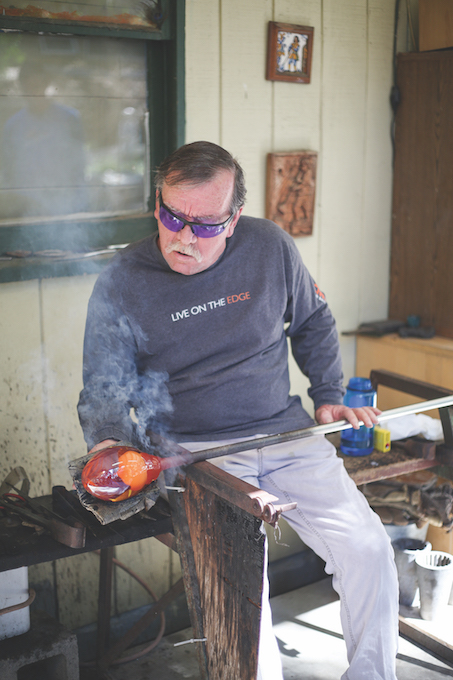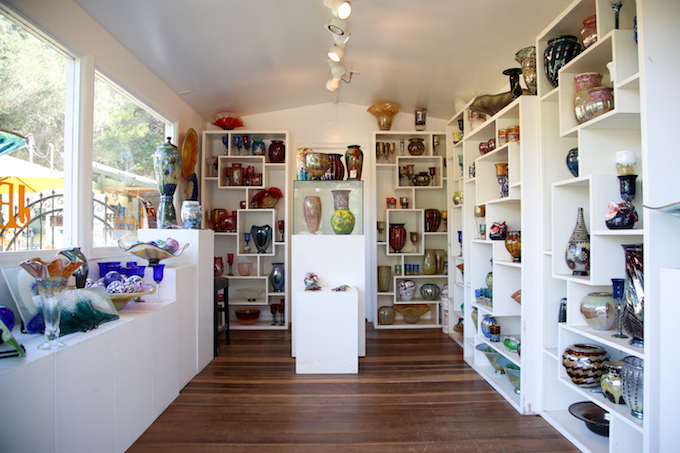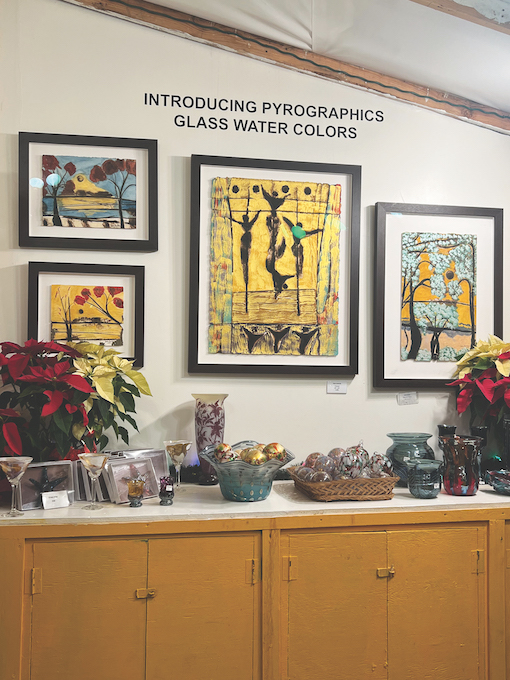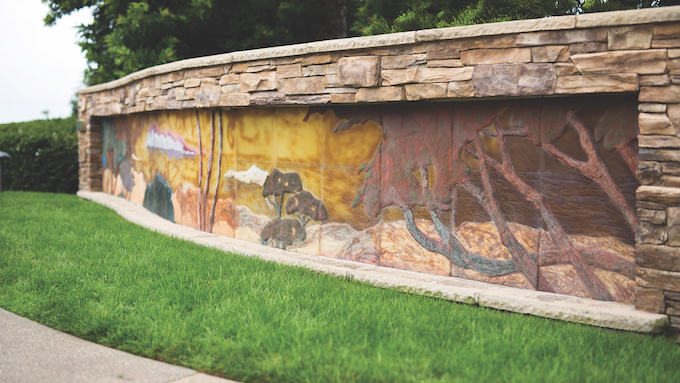
Glass blower and pyrographic artist John Barber discusses his lengthy history in Laguna and the impact that being part of this community has had on him.
By Ashley Ryan
It’s been nearly five decades since Laguna resident John Barber joined the local art scene, his creativity and innovation making him a favorite at Sawdust Art Festival year after year.
From glass blowing demonstrations and public art pieces to tabletop decor and pyrographic paintings, his prolific career has long been in the spotlight. On top of that, he has been crucial to expanding art education in town as well as mentoring up-and-coming glass blowers to ensure that his craft lives on.
But a recent lung cancer diagnosis has made Barber unsure of what the future holds, though he says he has no plans to quit. “I will never retire as long as I can still do this,” Barber notes. However long he is able to showcase his creations, his legacy in Laguna will live on through his dedication to his craft and the heart and soul he puts in to each and every piece.
Looking Back
Although many aren’t aware, Barber has a fascinating history even before glass blowing. “My parents divorced when I was 5,” he notes. “I had my time with my father and I had my time with my mother. … As a young boy, I wanted to be a Formula One driver so, at the age of 9, [my father and I] … started racing go-karts together.”

As a teenager, Barber established himself on the racetrack, becoming a national champion. “Basically, that’s where I was raised—on the racetrack,” he says. “I loved it. I thought that was going to be my passion. And when I was 18, I had two dear racing friends get in a terrible accident and were crippled. … I started thinking there must be something else just as exciting as going 150 mph.”
Barber also struggled with the idea of going to battle, as he was part of a draft lottery during the Vietnam War. “I had pretty much made up my mind: ‘I’m not going to go to war,’ ” he recalls. “I sold everything, bought a Honda motorcycle … and went to Canada.” His lottery number was not selected so he was able to return home. But, still left wondering what else he should do, he set out for Munich, Germany, where his sister lived.
It was here that Barber encountered glass blowing for the first time. His brother-in-law grew up in a village in Bavaria where they had been blowing glass for 1,200 years. After meeting renowned glass blower Erwin Eisch, Barber became enthralled with the medium. “My mother and two sisters were painters,” he notes. “… At that time, I swore I would never touch anything flat. They were just so good at it. Then I found glass and it was round and I said, ‘Oh, I can own this.’ ”

He decided to stick around, apprenticing under Eisch before attending the state school of glasswork in Zwiesel for two years. A few years after he returned to California, Barber discovered the beauty of Laguna Beach and moved to town. In the late 1980s, he was able to move in to his current home/studio in Laguna Canyon—a whimsical piece of paradise zoned for residential/minimal industrial use that allows him to keep a furnace on-site, nestled in his garden.
Festival Features
It was 1977 when Barber made his debut at Sawdust Art Festival, an event that he still shows in twice a year (including Winter Fantasy). He also exhibited at Festival of Arts for 25 years, noting that the shows served their own distinct purposes. “I used to like the fact that I had a venue to feature something new and then I had a venue to feature all of the work I do,” he says.
He was especially drawn to the Sawdust festival, largely due to its mission to help local artists and because of its demonstration venue that allowed him to show people what it takes to blow glass at a time when the medium was not yet popular in America. “When I came to the Sawdust in 1977, the people that were making all the money and in the national spotlight were the ceramicists,” he notes. “… It took a good 20 years, then we started to have national glass artists bringing attention to glass.”

Before the permanent demonstration booth they have now, they had to build the furnace each year and then tear it down at the end of the summer. “It was a lot of work, but it was quite a benefit,” he recalls. “We would announce a glass blowing demonstration and boom—there would be 100 people there.”
Barber also served on the festival’s board of directors from 2000 to 2004 and, prior to that, developed its Spring Into Art program in an effort to bring more art education to Laguna. “That’s our mission, to educate the public into the arts, and it wasn’t being done,” Barber says. “… They gave me a budget of $500, … and it was a success and has carried on to this day.” These classes, now held year-round during the festival’s off-season, encompass everything from jewelry, painting, photography and leather art to woodworking, sculpture and—of course—glass blowing.
For more than a decade now, he has sold his pieces exclusively at the Sawdust and his personal showroom, which is also located at his Laguna Canyon compound. “I used to do shows on weekends, but now I can’t leave on weekends because that’s when everybody shows up and buys stuff. So I just stay home,” Barber explains. “How great is that?”

Though he has tried to wholesale items in the past, he says selling his artwork himself brings him the greatest joy. “I realized that what I really enjoy is my personal connection with the collectors,” he explains. “They are interesting people that have these tastes that I like, so I get the most reward out of selling it myself.”
Barber also hosts workshops on the weekends where visitors can come in with no experience and leave with multiple pieces of glass art that they created (with some help). The four-hour sessions are $500 for two people, and he says the requests have been steadily increasing as of late. “I feel very lucky to have come to glass at a time in American history where it is now appreciated and collected,” he says.
Radical Reinvention
Throughout his career, Barber has strived to embrace challenges and reinvent himself. “I feel it’s the role of the artist to innovate, not reproduce,” he says. In fact, he dedicates six weeks each year to experimenting and creating new pieces with his collectors in mind.
But one of the biggest changes to his body of work—which includes vases, stemware, bowls and sculptures—has been the addition of what he calls pyrographic paintings. Dreamed up during the COVID-19 pandemic, when the festivals were closed, these unique artworks are the result of Barber seeking out a medium he could produce more easily as he ages. “Physically, I’m not going to be able to blow glass until I’m 90 years old,” Barber notes. “So I thought, ‘What’s another medium that would benefit from the eyes of a glass blower?’ ”

He decided to use his furnace to incorporate glass into painted pieces. With a heavy sheet of watercolor paper placed on a piece of plywood, Barber drips molten glass across the page to form an image. Quickly sprayed with water so that the paper doesn’t ignite, he then mixes his own watercolors using powdered colored glass—a technique discovered by Chinese and Japanese artists in ancient times.
“I then realized that the vividness of these colors is so striking,” Barber says. “The iridescence I can get—the different textures and feels I can get with different grains of this powdered glass. … You touch this and it feels like sandpaper.”
He began showing them at the Sawdust in 2021, and he says that people were intrigued by what he was doing. “It inspired me to go on and make more. There’s nothing like it. … I sit down to paint and I’m just smiling ear to ear. I’m learning so much. Each piece is an original and is coming out so different than anything I’ve ever done.

“But this isn’t the first time I reinvented myself,” he adds. In the 2000s, Barber was approached by an art consultant about designing a proposal for a public art piece at Montage Laguna Beach. Despite some initial hesitation about including glass in the entryway, the resort selected his bid and he crafted Eternal Sunset, which featured 16 panels cast using a technique called “pate de verre,” meaning glass paste. “Being my first public art piece, it changed my life,” Barber says. “It opened me up to more things I can do than tabletop work and was a large step for me.”
Community Impact
While Barber’s talent and skill are undeniable, few places would have launched his career the way Laguna Beach did. He has been embraced by the local art community from the start and has given back by personally mentoring glass artists who are now showing alongside him at the festival. “I’m compelled to pass this on,” he explains. “… These artists I’ve brought in have wonderful careers ahead of them.”
But lucky are they to have learned from a master at his craft. Barber has been producing 10 tons of art glass a year for well over four decades, with his pieces landing in far-off destinations like France, Indonesia and beyond.
His mere presence at the local festivals have also inspired the next generation, with people visiting his booth to tell him that their parents brought them to Sawdust when they were growing up to watch his glass blowing demonstrations. “They saw me blow glass to Van Halen,” Barber says with a smile. “… They remember the music, they remember me and they went on to tell me it changed their life.”

Barber says his sales have been better than ever and he is extremely moved by the things he has heard from customers this year. “Now that my health is in jeopardy, I felt it even more important to be there,” he explains. “This last summer, it was overwhelming to me—the number of people every day that would come there and tell me they’ve been collecting my work for 40 years, for 30, 20, 10 years. … I am just so in love with this community that has supported me for so long.”
On tours of his glass blowing compound, Barber says he gives a demonstration, shows guests around the studio then brings them to the showroom so they can buy as many pieces as they wish. “I’ve done it for years, and these are professional people: accountants, lawyers, doctors,” Barber notes. “But what I hear more often than not is, when they’re leaving this place, they go, ‘John Barber, you live the life we all dream of.’ It took me a while to believe what they’re saying. … But my life has been a dream. It really has.”
